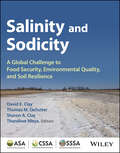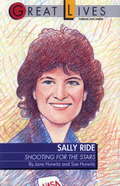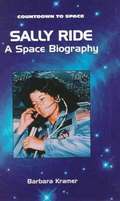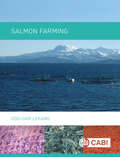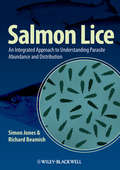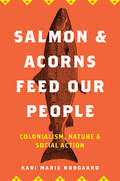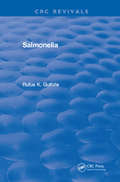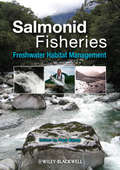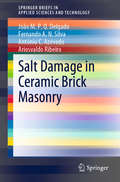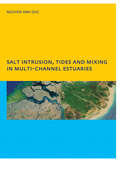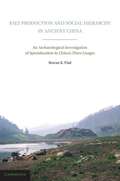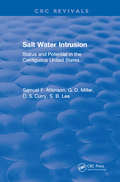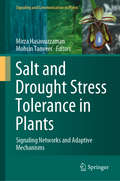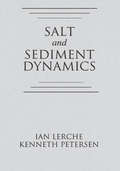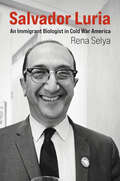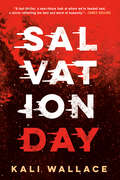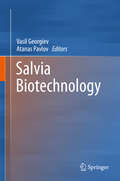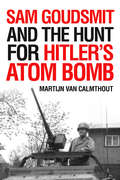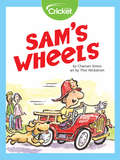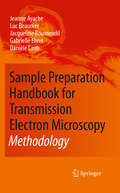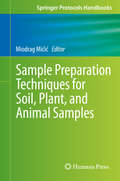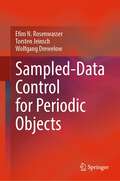- Table View
- List View
Salinity and Sodicity: A Growing Global Challenge to Food Security, Environmental Quality and Soil Resilience (ASA, CSSA, and SSSA Books)
by Sharon A. Clay David E. Clay, Thomas M. DeSutter Thomas M. DeSutter Thandiwe NleyaExplore the growing problem of soil salinity and sodicity and its impact on the environment, profitability, the human population, and soil resilience In Salinity and Sodicity: A Global Challenge to Food Security, Environmental Quality, and Soil Resilience, a team of distinguished educators delivers an expert discussion of salinity and sodicity management. This book is designed to improve the problem-solving capabilities of students, soil health professionals, certified crop advisors, and other practicing professionals in this area. In addition to an introduction to the causes of a rapidly growing problem, Salinity and Sodicity explores different measurement techniques, provides answers to common questions, provides potential solutions in a way that’s appropriate for introductory classes on soil salinity and sodicity management. It’s an ideal reference manual for professionals, as well as an effective tool for classrooms and crop advisor workshops. Readers will also find: A thorough introduction to the use of supplemental irrigation and the impact of salts on the environmentComprehensive explorations of the economic considerations for farming problematic soilsPractical discussions of the effects of salinity and sodicity on erosion and greenhouse gas emissionsPractical case studies, problem sets, and an instructor answer key Perfect for undergraduate, graduate, and doctoral students and certified and practicing soil professionals and advisors, Salinity and Sodicity will also benefit industry and academic researchers with an interest in soil salinity and sodicity in dryland regions.
Sally Ride
by Sue HurwitzSally RideShooting for the StarsAstronaut Dr. Sally Ride took a deep breath and nervously waited as the powerful engines of the Space Shuttle Challenger roared to life. This was the most frightening, yet exciting moment of Sally's life! She was determined to prove that an American woman could perform in space as well as a man.Countdown to History!Sally Ride: Shooting for the Stars profiles the life of America's first woman astronaut to fly in space. Jain Sally's astronaut training as she learns to fly jets, practices sea rescue missions, and floats weightlessly in a special "zero gravity" aircraft. Witness her breathtaking view of Earth from 184 miles out in space while traveling aver 17,400 miles per hour! Then dare to share her dream of joining NASA's astronaut program.From the Trade Paperback edition.
Sally Ride: A Space Biography
by Barbara KramerOn the morning of June 18, 1983, the United States sent its first woman -- Sally Ride -- into space. The book tells the story of Sally Ride, from her youth through her astronaut training. As a mission specialist, she conducted research on pharmaceuticals and the use of the new shuttle's robot arm. The book also discusses her career as a teacher and researcher after retiring from NASA.
Salmon Farming
by Odd-ivar LekangAquaculture production is expanding worldwide in both volume and scope, with a number of new species being introduced to aquaculture every year. This book provides an overview of aquaculture production systems focusing on Atlantic salmon farming, which will enable users to: - produce broodstock, juveniles and adult fish; - develop a production plan for juvenile and ongrowing farms; - evaluate and optimize the key working operations on juvenile and ongrowing farms; - identify the factors that are important for economic and sustainable production; - identify the factors that affect the rate of production, how these factors can be changed, and what effects such changes have; - adopt the best procedures for season-independent smolt production; - understand water quality requirements and evaluate the suitability based on water analysis; - prepare documents for production control and propose amendments; - prepare working plans for smolt production and ongrowing production farms; - establish maintenance routines/plans for smolt production and ongrowing production; - estimate the investment and running cost for the main components of smolt and ongrowing farms; - remain up to date with the laws and regulations that need to be considered in aquaculture production planning internationally; and - stay abreast of new trends in the industry. Much of the subject coverage and overall structure of the book is directly transferable to other species, with the core content being species-independent and applicable internationally.
Salmon Lice: An Integrated Approach to Understanding Parasite Abundance and Distribution
by Simon Jones Richard BeamishThe salmon louse Lepeophtheirus salmonis is adapted to survive in hostile marine environments of the northern hemisphere, including an ability to parasitize several species of salmon. Salmonids are some of the most economically important and sought after fish for human consumption, and louse parasitism has a significant impact both on cultured and wild fish populations. Salmon Lice is a timely collection of the latest research on the cause and spread of lice infestations and management techniques being designed and implemented to combat this issue. Salmon Lice provides a thorough single volume review of Lepeophtheirus salmonis, the key parasite standing in the way of sustainable and profitable production of salmonid fishes including salmon, trout and charr. Opening with a review of the biology, morphology, life cycle, and larval behavior of the parasite, Salmon Lice proceeds to review the distribution of planktonic larvae of salmon lice, addresses management techniques used in salmonid aquaculture and capture fisheries, provides a practical assessment of the salmon lice issue and explores potential solutions to the problem. With comprehensive coverage of the biology and distribution of this harmful and ubiquitous parasite, Salmon Lice will be of value to fish health researchers, aquaculture and fisheries professionals, and seafood industry personnel to inform the management of both cultured and wild salmonid populations. Key Features: In-depth coverage of a key parasite impacting viability and sustainability of salmonid fisheries and aquaculture Integrates parasite biology and hydrodynamic models in diverse coastal ecosystems Provides a practical assessment of the salmon louse issue Reviews international salmon louse monitoring and management techniques used in salmonid fisheries and aquaculture
Salmon and Acorns Feed Our People: Colonialism, Nature, and Social Action (Nature, Society, and Culture)
by Kari Marie NorgaardSince time before memory, large numbers of salmon have made their way up and down the Klamath River. Indigenous management enabled the ecological abundance that formed the basis of capitalist wealth across North America. These activities on the landscape continue today, although they are often the site of intense political struggle. Not only has the magnitude of Native American genocide been of remarkable little sociological focus, the fact that this genocide has been coupled with a reorganization of the natural world represents a substantial theoretical void. Whereas much attention has (rightfully) focused on the structuring of capitalism, racism and patriarchy, few sociologists have attended to the ongoing process of North American colonialism. Salmon and Acorns Feed Our People draws upon nearly two decades of examples and insight from Karuk experiences on the Klamath River to illustrate how the ecological dynamics of settler-colonialism are essential for theorizing gender, race and social power today.
Salmonella
by Rufus K. GuthrieSalmonella deals with the common infectious disease, Salmonellosis, which is commonly foodborne and is easily spread in any kitchen. The source of the pathogenic organisms is frequently poultry and the organism is often spread in the kitchen from poultry to other foods. This book describes the organisms, paths of transmission, infection and its treatment, and the control of the spread of the disease. The book is written so that food handlers at all levels can readily understand the material included. The book will also be easily understood by the lay person who could find it useful in any kitchen. Salmonella is excellent as a text or supplementary reading for food technology classes and sanitation classes.
Salmonid Fisheries: Freshwater Habitat Management
by Paul KempSalmonid Fisheries is a landmark publication, concentrating on river management, habitat restoration and rehabilitation, disseminating lessons learnt in relation to the intensively studied salmonids that are applicable to future interventions, not just for salmonid species but for other non-salmonid species, biota and ecosystems. The contents of this book are the product of the Atlantic Salmon Trust’s 40th Anniversary Conference, held in association with the Game and Wildlife Conservation Trust. Drawing together carefully-edited contributions from many of the world leaders in river restoration from academia, commercial management and government agencies, this important book highlights the need to view river management from the context of the catchment and to adopt an ecosystem-based approach to restoration. The book is broadly divided into two sections which discuss first, the status of current understanding concerning the relationship between lotic habitat management, the response of salmonid fisheries and the theory of river restoration, and secondly, the application of this to habitat management and river restoration. Salmonid Fisheries is an extremely valuable work of reference for fisheries managers, ecologists, environmental scientists, fish biologists, conservation biologists and geomorphologists. Libraries in all universities and research establishments where biological and earth sciences, and fisheries management are studied or taught should have copies of this book on their shelves. Contributions from a wide range of well known experts Published in association with the Atlantic Salmon Trust Habitat management is crucial for dwindling wild salmon populations Of great importance to aquatic ecologists and fisheries managers
Salt Damage in Ceramic Brick Masonry (SpringerBriefs in Applied Sciences and Technology)
by António C. Azevedo Fernando A.N. Silva João M.P.Q. Delgado Ariosvaldo RibeiroThis book discusses the effects of soluble mineral salts on ceramic brick masonry walls in Petrolina, a city in Pernambuco, Brazil, located 780 km from the ocean. To shed light on this phenomenon, the authors mapped the pathologies originating from the effects of soluble mineral salts and installed wells to monitor the underground water supply at five locations in the city where the phenomenon most frequently occurs. Further, they analyzed samples of soil, groundwater, and bricks affected by the phenomenon and measured levels of chloride in the atmosphere at these sites. The results obtained indicate that the pathological manifestations are influenced by the high levels of soluble salts observed in the soil and groundwater samples collected, and are not affected by chloride in the atmosphere.
Salt Intrusion, Tides and Mixing in Multi-Channel Estuaries: PhD: UNESCO-IHE Institute, Delft
by Anh Duc NguyenMulti-channel estuaries, such as the Mekong Delta in Vietnam and the Scheldt in the Netherlands, have characteristics of both the river and the sea, forming an environment influenced by tidal movements of the sea and freshwater flow of the river. This study discusses a predictive analytical approach for salinity intrusion and discharge estimate in multi-channel estuaries. The new approach agrees with 1-D hydrodynamic models and observations, indicating its applicability in practice. It has successfully developed a new theory and a new equation to quantify tidal pumping due to ebb-flood channel residual circulation and the related salt dispersion.
Salt Production and Social Hierarchy in Ancient China
by Rowan K. FladThis book examines the organisation of specialised salt production at Zhongba, one of the most important prehistoric sites in the Three Gorges of China's Yangzi River valley. Rowan K. Flad demonstrates that salt production emerged in the second millennium BCE and developed into a large-scale, intense activity. As the intensity of this activity increased during the early Bronze Age, production became more coordinated, perhaps by an emergent elite who appear to have supported their position of authority by means of divination and the control of ritual knowledge. This study explores evidence of these changes in ceramics, the layout of space at the site and animal remains. It synthesises the data retrieved from years of excavation, showing not only the evolution of production methods, but also the emergence of social hierarchy in the Three Gorges region over two millennia.
Salt Water Intrusion
by Samuel F. AtkinsonThis book provides a summary of the status and potential for salt water intrusion into ground water in the contiguous united states. While the focus is on resultant limitation in the agricultural usage of ground water, the book is not limited to this singular limitation in resource usage.
Salt and Drought Stress Tolerance in Plants: Signaling Networks and Adaptive Mechanisms (Signaling and Communication in Plants)
by Mirza Hasanuzzaman Mohsin TanveerThis book presents various aspects of salt and drought stress signaling in crops, combining physiological, biochemical, and molecular studies. Salt and drought stress are two major constraints on crop production worldwide. Plants possess several mechanisms to cope with the adverse effects of salt and drought. Among these mechanisms, stress signaling is very important, because it integrates and regulates nuclear gene expression and other cellular activities, which can help to restore cellular homeostasis. Accordingly, understanding the signaling cascades will help plant biologists to grasp the tolerance mechanisms that allow breeders to develop tolerant crop varieties. This book is an essential resource for researchers and graduate students working on salt and drought stress physiology and plant breeding.
Salt and Sediment Dynamics
by Kenneth Petersen Ian LercheSalt and Sediment Dynamics presents a thorough treatment of salt and sediment interactions and the implications of such interactions for sub-salt exploration. The book emphasizes and utilizes recent discoveries on many aspects of salt and sediment interactions, provides the theoretical framework for interpreting the increasing amount of available data on salt and sediments, and develops a self-consistent dynamical evolution model of salt structures and their interaction with surrounding sediments. The model developed in the text consists of an evolving salt structure that influences sediment motion with self-consistent evolution of sediments and salt shape. The resulting stress and strain in the sediments and the thermal focusing effects of the salt are evaluated. The salt and sediments in the model are consistent with observed geometries, a result of having freely adjustable, observation-controlled model parameters. In addition, the book describes case histories in a variety of geological settings, thus explaining aspects of the genesis and development of salt structures, of their impact on sedimentary structural evolution, and of the impact of sediments on salt masses. The techniques developed by the authors expand the current state of knowledge regarding the evolution and dynamics of salt structures and increase the potential for effective sub-salt hydrocarbon exploration.
Salt-affected Soils and Marginal Waters: Global Perspectives and Sustainable Management
by Ranbir ChhabraThis book presents systematic scientific appraisal, classification, genesis and viable technologies for reclamation and management of salt-affected soils and marginal quality waters across India and several other countries. Nature, solubility and geo-chemical mobility of salts have been provided as basis for the development of alkali and saline soils and groundwaters under specific agro-hydro-ecological regions. Chemical amendment (gypsum) based reclamation technology of alkali soils and related pre and post-reclamation water, nutrient and crop management interventions, including re-sodification issues have been comprehensively addressed. Features and operational guidelines of surface, subsurface, vertical and bio-drainage systems have been thoroughly discussed; likewise, amelioration of irrigation induced saline soils in inland and coastal regions and preventive measures for control of salinity and waterlogging along with environmental trade-offs. Practical approaches for amelioration and judicious use of saline, alkali, high SAR- saline and waste waters have been synthesized for different cropping and agro- forestry systems. Emerging issues on use of industrial by-products as amendments for alkali soils, physiological aspects of salt resistance, anatomical and biochemical mechanism of submergence tolerance, specific ion effects of poor quality waters, crop diversification, groundwater recharge, rejuvenation of tsunami affected coastal soils, safety against occurrence of poisonous gas in tube well pits, paddy straw burning and others have been adequately deliberated upon. Combining scientific principles with field experiences, the book is expected to serve as a useful knowledge base for research workers, teachers and students of soil science, agronomy, plant breeding, forestry, irrigation engineering, extension workers, environmentalists and planners associated with reclamation and management of salt affected soils and waters on sustainable basis in developing and developed countries.
Salvador Luria: An Immigrant Biologist in Cold War America
by Rena SelyaThe life of Nobel-winning biologist Salvador Luria, whose passion for science was equaled by his commitment to political engagement in Cold War America.Blacklisted from federal funding review panels but awarded a Nobel Prize for his research on bacteriophage, biologist Salvador Luria (1912–1991) was as much an activist as a scientist. In this first full-length biography of Luria, Rena Selya draws on extensive archival research; interviews with Luria&’s family, colleagues, and students; and FBI documents obtained through the Freedom of Information Act to create a compelling portrait of a man committed to both science and society.In addition to his work with viruses and bacteria in the 1940s, Luria broke new ground in molecular biology and cancer research from the 1950s to the 1980s and was a leader in calling for scientists to accept an educational and advisory responsibility to the public. In return, he believed, the public should rely on science to strengthen social and political institutions.Luria was born in Italy, where the Fascists came to power when he was ten. He left Italy for France due to the antisemitic Race Laws of 1938, and then fled as a Jewish refugee from Nazi Europe, making his way to the United States. Once an American citizen, Luria became a grassroots activist on behalf of civil rights, labor representation, nuclear disarmament, and American military disengagement from the Vietnam and Gulf Wars. Luria joined the MIT faculty in 1960 and was the founding director of the Center for Cancer Research. Throughout his life he remained as passionate about his engagement with political issues as about his science, and continued to fight for peace and freedom until his death.
Salvation Day
by Kali WallaceA lethal virus is awoken on an abandoned spaceship in this incredibly fast-paced, claustrophobic thriller.They thought the ship would be their salvation. Zahra knew every detail of the plan. House of Wisdom, a massive exploration vessel, had been abandoned by the government of Earth a decade earlier, when a deadly virus broke out and killed everyone on board in a matter of hours. But now it could belong to her people if they were bold enough to take it. All they needed to do was kidnap Jaswinder Bhattacharya—the sole survivor of the tragedy, and the last person whose genetic signature would allow entry to the spaceship. But what Zahra and her crew could not know was what waited for them on the ship—a terrifying secret buried by the government. A threat to all of humanity that lay sleeping alongside the orbiting dead. And then they woke it up.
Salvia Biotechnology
by Vasil Georgiev Atanas PavlovThe genus Salvia represents nearly 1,000 species that are widely distributed around the world. It is the largest in the Lamiaceae family. Traditionally, infusions of Salvia species have been widely used to treat oral inflammation, throat and headaches, and digestive disturbances in various folklore- and ethno-medicine practices worldwide. The antispasmodic, antiseptic and hypoglycemic effects of their extracts have been recognized by the ancient healers a long time ago before the development of modern medicine. With the advances in phytochemistry and pharmacology, terpenes, polyphenols and volatile compounds have been recognized as the source of bioactivity in Salvia extracts. Nowadays, because of their valuable pharmaceutical and nutraceutical properties, many Salvia species have been widely used as ingredients in food, pharmacy and cosmetic industries. The economic importance of Salvia plants continues to increase, following closely the growing interest to the concept for modern healthy lifestyle, based on prevention by consuming quality foods and nutraceutical supplements of natural origin. However, the growing demand has led to overexploitation of natural habitats and in the last few years many wild growing Salvia species have shrunk or fallen under threat. Obviously, to deal with that problem and to prevent ecological crisis, there is an urgent need for alternative, renewable sources of Salvia biomass. Plant biotechnology can provide a wide range of tools for development of economically feasible continuous production of standardized valuable phytochemicals. Plant in vitro culture technology is a powerful method for continuous production of plant secondary metabolites under controlled conditions, recently adapted to various Salvia species. Salvia in vitro systems are harmless to natural plant populations and can be grown independently of environmental factors, geographical latitude, climatic change, and seasonal variations. Several bioactive metabolites from rare and endangered Salvia plants can be produced by employing different plant in vitro systems. However, the researches on development of large scale biotechnology, based on Salvia in vitro systems, are still in early stages and many points still have to be addressed before the commercialization to take place. In this book we intend to summarize the recent achievements in research with Salvia in vitro systems as biological matrixes for the production of pharmaceutically important secondary metabolites. Further we invited leading experts to present their recent studies on phytochemistry, ethnobotanical and ethnophamacological aspects of genus Salvia. Safety and legal issues related to implementation of Salvia plants and in vitro cultures extracts in foods, cosmetics and pharmaceutical products will be discussed as well.
Sam Goudsmit and the Hunt for Hitler's Atom Bomb
by Martijn Van CalmthoutThe first biography in English of a leading Dutch American physicist, who discovered the subatomic property of "spin" and spearheaded the search for Hitler's atom bomb as World War II came to an end.This engaging biography of an important Dutch physicist brings to light his significant scientific contributions and remarkable life story. Based on recently released archives and material from Goudsmit's daughter Esther, science journalist Martijn van Calmthout has reconstructed a life marked by both brilliance and tragedy.As a young man Sam Goudsmit came to international attention when he and a colleague published a seminal paper that introduced the property of electron spin into atomic theory. This discovery helped to remove remaining questions about atomic theory and brought him into contact with the likes of Einstein, Heisenberg, and other leading physicists of the early 20th century. In 1927, he was offered a position at the University of Michigan and moved with his wife to the United States. When the Nazis invaded the Netherlands, Goudsmit, a Jew, feared for the lives of his parents and other family members still in Holland. His attempts to get his German colleague Werner Heisenberg to intervene on their behalf proved fruitless. Toward the end of World War II, he was recruited by the Department of Defense as the scientific leader of the co-called Alsos mission, whose task was to search for evidence of German atom-bomb development. The team eventually found stores of uranium ore and a nuclear reactor, among other evidence. While in Europe, Goudsmit had an opportunity to return to The Hague, his hometown. There in the rubble of his parent's house, he discovered that they had been deported to Auschwitz.After the war, he returned to the United States and became the editor of Physical Review and Physical Review Letters; the latter is a leading physics journal to this day. But guilt over his failure to save his parents haunted him for the rest of his life.This is a biography that in part reads like a thriller and restores long-overdue recognition to an important 20th-century physicist.
Sam the Man & the Cell Phone Plan (Sam the Man #5)
by Frances O'Roark DowellSam Graham wants a cell phone to help him with his research, but when his parents say no, he has to come up with another way to keep all the info he needs in his pocket in this hilarious fifth chapter book in the Sam the Man series from Frances O’Roark Dowell.Here are the facts: Sam Graham is an information man. But to get information, you need to do research. You never know when you’ll need an urgent piece of info—like, say, the number for a chicken emergency hotline—so a resource for instant research is a must! This is why Sam needs a cell phone. Unfortunately, Mom and Dad disagree. So, Sam has to come up with a plan. But what is small enough to fit in your pocket and can hold all the information you need? Sam will have to go old-school with his latest plan and use a handy notebook instead. Luckily, retro is in, and a la Nick in Andrew Clements’s Frindle, Sam might just start the latest trend!
Sam's Wheels
by Charnan SimonSam needs a lesson in how his fire truck works! When his toy truck is broken, his neighbor Mrs. Carpenter teaches him how to fix a broken wheel.
Samira and the Skeletons
by Camilla KuhnSamira likes school, especially when she gets to sit next to her best friend, Frida. But when they learn about the skeletal system in science class, Samira suddenly begins to imagine everyone in school as a walking skeleton. Soon she starts avoiding her fellow classmates, even Frida, but Samira still can't escape her own skeleton. With some clever help from her mother, though, Samira realizes that maybe having a body full of bones isn't necessarily a bad thing.Enhanced by delightfully impish illustrations, Camilla Kuhn's playful book depicts the hilarious results of an imagination gone awry.
Sample Preparation Handbook for Transmission Electron Microscopy: Methodology
by Jeanne Ayache Danièle Laub Jacqueline Boumendil Gabrielle Ehret Luc BeaunierThis two-volume Handbook is a comprehensive and authoritative guide to sample preparation for the transmission electron microscope. This first volume covers general theoretical and practical aspects of the methodologies used for TEM analysis and observation of any sample. The information will help you to choose the best preparative technique for your application taking into account material types, structures, and their properties. Physical properties, material classification, and microstructures are considered together with a thorough description of the physics and chemistry of sample preparation and the main artifacts brought about by mechanical, physical and chemical methods, principles which are also applicable to sample preparation for the SEM, AFM etc.. Also included is a discussion of how to combine techniques for complex sample analysis and to obtain a TEM thin slice. Sample Preparation Handbook for Transmission Electron Microscopy: Methodology will guide you through the most current techniques for successful sample preparation in all fields from materials science to biology. The remainder of the book is dedicated to technical hints, including 22 detailed protocols for preparing thin slices for TEM analysis. Experimental conditions and guidelines, options and variations, advantages and constraints, common artefacts, and theoretical issues are considered. Particular attention is given to the type of material, conditioning, compatible analysis of a given preparation, and risks. Finally, a practical, authoritative, and interdisciplinary handbook is available to guide you through all of the most current techniques for successful sample preparation in all fields from materials science to biology.
Sample Preparation Techniques for Soil, Plant, and Animal Samples
by Miodrag MicicThis protocol volume will be the first publication to comprehensively cover entire spectrum of molecular biology sample preparation techniques commonly used to extract and isolate nucleic acids, proteins and other molecules of interests, from plants, animals and environmental samples and similar difficult samples. Sample preparation is considered to be the first and most significant bottleneck in the molecular biology lab workflow, and it is very peculiar fact that while there is an estimated $3. 6B market (Bcc Research Report # BIO089A, 2010) in sample preparation consumables and equipment for Genomics, Proteomics, and Epigenetics; and that approximately 180,000 people worldwide are performing sample preparation techniques in the lab daily, there is no single book dealing exclusively with this topic. The proposed book will present an in depth literature review of current state-of-the-art knowledge in all aspects of molecular biology related sample preparations methods, techniques and applications, and provide a comprehensive collection of practical recipes and advice on the most efficient methods of processing the most common sample types in agriculture, plant science, soil science, environmental science, and animals research. The book will be an essential tool for demystifying time consuming, and often the last remaining bottleneck process in molecular biology sample preparation and will be of special interest to all lab technicians bench scientists, graduate students, postdocs, as well as other senior scientists working with DNA, RNA and Proteins in such a diverse areas ranging from plant, soil, environmental science, animal research, as well as to more applied fields of quality control and law enforcement.
Sampled-Data Control for Periodic Objects
by Efim N. Rosenwasser Torsten Jeinsch Wolfgang DrewelowThis book is devoted to the problem of sampled-data control of finite-dimensional linear continuous periodic (FDLCP) objects. It fills a deficit in coverage of this important subject. The methods presented here are based on the parametric transfer matrix, which has proven successful in the study of sampled-data systems with linear time-invariant objects. The book shows that this concept can be successfully transferred to sampled-data systems with FDLCP objects. It is set out in five parts:· · an introduction to the frequency approach for the mathematical description of FDLCP objects including the determination of their structure and their representation as a serial connection of periodic modulators and a linear time-invariant object; · construction of parametric transfer matrix for different types of open and closed sampled-data systems with FDLCP objects; · the solution of problems of causal modal control of FDLCP objects based on the mathematical apparatus of determinant polynomial equations; · consideration of the problem of constructing a quadratic quality functional for the H2-optimization problem of a single-loop synchronous sampled-data system with control delay; · description of the general H2-optimization procedure. Necessary mathematical reference material is included at relevant points in the book. Sampled-Data Control for Periodic Objects is of use to: scientists and engineers involved in research and design of systems of systems with FDLCP objects; graduate students wishing to broaden their scope of competence; their instructors; and mathematicians working in the field of control theory.
